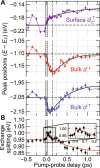Ultrafast spin transfer and its impact on the electronic structure
- PMID: 39018415
- PMCID: PMC466954
- DOI: 10.1126/sciadv.adn4613
Ultrafast spin transfer and its impact on the electronic structure
Abstract
Optically induced intersite spin transfer (OISTR) promises manipulation of spin systems within the ultimate time limit of laser excitation. Following its prediction, signatures of ultrafast spin transfer between oppositely aligned spin sublattices have been observed in magnetic alloys and multilayers. However, it is known neither from theory nor from experiment whether the band structure immediately follows the ultrafast change in spin polarization or whether the exchange split bands remain rigid. We show that ultrafast spin transfer occurs even in ferromagnetic gadolinium metal. Charge transfer between localized surface and extended valence-band states leads to a decrease of the surface spin polarization. This synchronously alters the exchange splitting of the bulk valence bands during laser excitation. Moreover, the onset of demagnetization can be tuned by over 200 fs by changing the temperature-dependent spin mixing. Our results show a promising route to ultrafast control of the magnetization, widening the impact and applicability of OISTR.
Figures





References
-
- Beaurepaire E., Merle J.-C., Daunois A., Bigot J.-Y., Ultrafast spin dynamics in ferromagnetic nickel. Phys. Rev. Lett. 76, 4250–4253 (1996). - PubMed
-
- Stanciu C. D., Hansteen F., Kimel A. V., Kirilyuk A., Tsukamoto A., Itoh A., Rasing T., All-optical magnetic recording with circularly polarized light. Phys. Rev. Lett. 99, 047601 (2007). - PubMed
-
- Kirilyuk A., Kimel A. V., Rasing T., Laser-induced magnetization dynamics and reversal in ferrimagnetic alloys. Rep. Prog. Phys. 76, 026501 (2013). - PubMed
-
- Ostler T., Barker J., Evans R., Chantrell R., Atxitia U., Chubykalo-Fesenko O., El Moussaoui S., Le Guyader L., Mengotti E., Heyderman L., Nolting F., Tsukamoto A., Itoh A., Afanasiev D., Ivanov B., Kalashnikova A., Vahaplar K., Mentink J., Kirilyuk A., Rasing T., Kimel A., Ultrafast heating as a sufficient stimulus for magnetization reversal in a ferrimagnet. Nat. Commun. 3, 666 (2012). - PubMed
LinkOut - more resources
Full Text Sources

